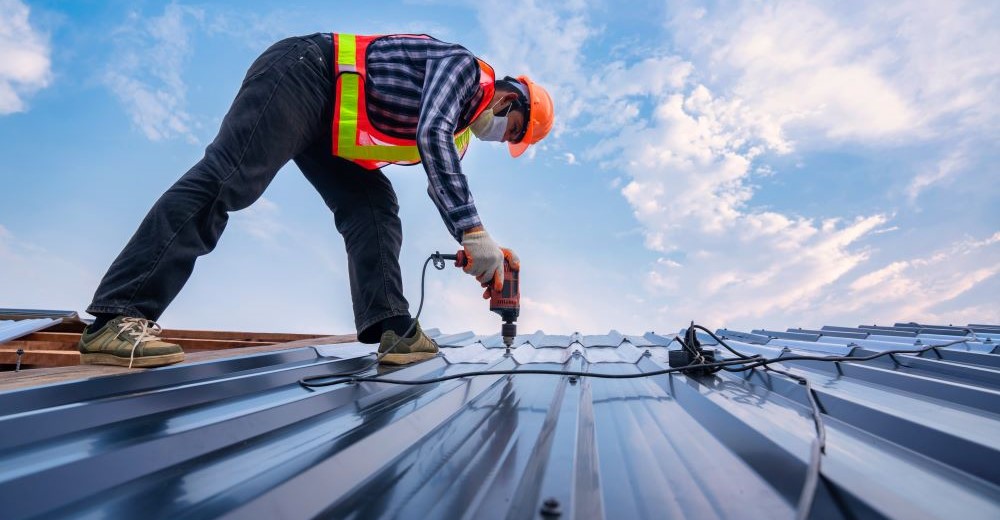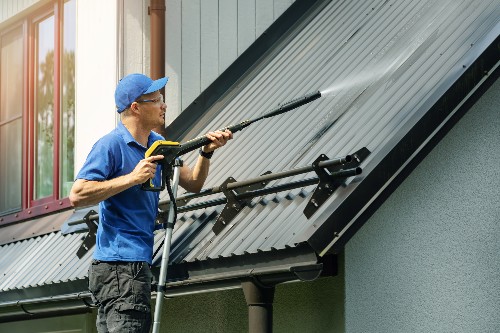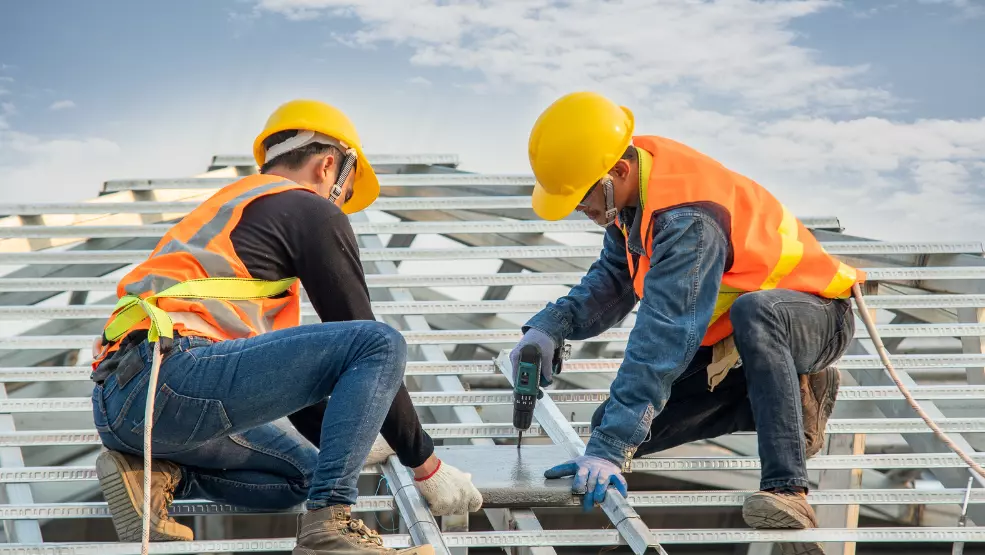Crucial Tips for Effective Roof Maintenance From Leading Roofing Experts
Preserving a roof is important for the durability of a home. Leading roof covering specialists emphasize the importance of normal evaluations to capture problems early. Furthermore, correct upkeep techniques can protect against costly repair services down the line. Home owners frequently neglect straightforward jobs that add to a roof covering's health and wellness. Comprehending these crucial tips can make a significant distinction. Nonetheless, lots of may wonder what certain methods are most efficient.
Routine Examinations: Trick to Early Problem Detection
Although many homeowners might neglect their roofs, normal evaluations play a necessary function in identifying possible problems before they escalate into costly fixings. A comprehensive examination can disclose indications of wear, such as missing out on shingles, splits, or rusted flashing. These apparently minor problems can lead to considerable leaks, structural damages, or mold and mildew growth if left unaddressed.
Specialists recommend carrying out evaluations a minimum of twice a year, ideally in the springtime and loss. This positive strategy allows house owners to catch issues early, guaranteeing the long life of the roof. Furthermore, after severe weather condition occasions, such as tornados or hefty snowfall, an assessment is important to assess any kind of resulting damages. Normal evaluations not only enhance the roof covering's life expectancy but also supply comfort, recognizing that the home is well-protected. By prioritizing this facet of maintenance, house owners can stay clear of unexpected expenditures and keep the honesty of their residential or commercial property.
Keep Gutters and Downspouts Clear
Normal maintenance of downspouts and rain gutters is essential for protecting against water damage to a home. Clogged up seamless gutters can result in overruning water, which may harm the exterior siding, roofing, and structure. To maintain peak feature, homeowners ought to routinely inspect and tidy seamless gutters, especially throughout autumn when leaves and particles collect.
Utilizing a durable ladder, people should get rid of any kind of obstructions, guaranteeing that water streams freely via the system. It is a good idea to check downspouts for obstructions too; a blocked downspout can trigger water to back up and overflow.
Furthermore, home owners should verify that gutters are firmly attached and correctly sloped to direct water toward downspouts. Installing rain gutter guards can likewise assist minimize debris build-up and reduce maintenance regularity. By keeping downspouts and gutters clear, home owners can shield their property from expensive water damages and extend the life-span of their roofing system.
Trim Overhanging Branches
To ensure the longevity of a roofing system, property owners need to prioritize cutting overhanging branches that pose a risk to their roofing system. Branches can cause substantial damages via various means, including direct call during storms or heavy winds, which may cause scrapes or slits in roofing materials. Additionally, overhanging branches can promote the development of moss and algae, as they supply color and wetness retention, compromising the roofing system's stability.
On a regular basis reviewing the distance between tree limbs and the roofing is crucial. Homeowners should intend to keep a secure clearance of a minimum of six feet to reduce possible threats. Using specialist tree services can guarantee secure and correct cutting, avoiding unintentional damages to the home. By proactively taking care of tree development, property owners can safeguard their roofing systems, improving their life expectancy and decreasing future maintenance costs. Finally, routine branch trimming is an essential aspect of effective roof covering upkeep.
Look for Indicators of Damage
Inspecting a roof for indications of damage is crucial for keeping its structural integrity and longevity (Roof Installation). House owners must carry out visual checks at the very least two times a year, concentrating on typical indicators of issues. Missing, fractured, or crinkled shingles can signify wear and tear, while discoloration may suggest water damage or leaks. Additionally, home owners need to check out flashing around smokeshafts, vents, and skylights for rust or gaps, as these locations are susceptible to leakages
Seamless gutters and downspouts ought to be removed of debris, as obstructions can lead to water merging and succeeding roofing damage. Interior inspections are also vital; water discolorations on ceilings or walls may recommend roofing leakages. Moreover, mold and mildew growth in attic rooms can indicate long term moisture exposure. By routinely inspecting for these indicators of damage, home owners can attend to concerns early, avoiding costly fixings and making certain the roof stays in prime problem.
Keep Appropriate Ventilation
Proper air flow is important for preserving a healthy and balanced roofing and lengthening Discover More Here its life-span. Ample air flow stops wetness build-up, which can result in mold and mildew and architectural damages. In addition, changing ventilation according to the seasons can enhance power performance and convenience within the home.

Relevance of Air movement
While numerous property owners may forget the value of air movement, maintaining appropriate ventilation is vital for the durability of a roofing system. Ample air movement assists control temperature within the attic room, protecting against warmth accumulation that can damage roofing products. This regulation also contributes to power effectiveness, decreasing the requirement for extreme air conditioning throughout hot months. Additionally, proper ventilation aids in distributing air evenly, decreasing the threat of deterioration on roofing parts. Professionals suggest setting up vents tactically to advertise a continual circulation of air, which helps in keeping an excellent atmosphere. House owners should prioritize air movement when conducting roofing upkeep, ensuring that their roofing systems stay intact and useful for years to come.
Stopping Dampness Build-Up
Maintaining sufficient ventilation not only controls temperature however additionally plays an important duty in protecting against moisture build-up within the attic room space. Proper ventilation permits for the continual flow of air, which aids to eliminate excess moisture that can collect from numerous resources, consisting of day-to-day activities and seasonal changes. Without ample air movement, moisture can lead to mold growth, timber rot, and damages to insulation, compromising the architectural honesty of the roofing system. Mounting vents, such as soffit and ridge vents, can boost air flow, making sure that wet air is expelled while fresh air is reeled in. Regularly checking and cleaning up these vents is crucial to preserving their effectiveness, thereby guarding the roofing and extending its life expectancy.
Seasonal Air Flow Adjustments
Seasonal adjustments considerably impact the ventilation demands of a roof covering. In warmer months, boosted temperature levels can catch warmth in the attic, resulting in potential damages and greater energy prices. Adequate air flow permits heat to escape, advertising a cooler indoor setting. On the other hand, throughout chillier months, proper air flow prevents wetness accumulation from snow and ice, which can lead to mold and architectural concerns. Roofing professionals suggest adjusting air flow systems seasonally, including using ridge vents and soffit vents for peak air movement. Routine inspections must guarantee that any type of blockages, such as particles or insulation, are removed. By maintaining suitable ventilation throughout the year, house owners can shield their roofs and improve power effectiveness.
Clean Your Roofing Surface Area
Cleaning up the roof surface is crucial for protecting its stability and prolonging its life-span. A tidy roof not only enhances the home's visual allure yet likewise avoids the buildup of moss, algae, and debris, which can add to degeneration. Routine cleansing helps to eliminate contaminants that might trap moisture, causing possible leaks and structural damage.
Property owners ought to consider using a soft-bristle brush or a stress washing machine with a reduced setup to delicately get rid of dirt and growths from the roof. It is necessary to prevent extreme chemicals that can damage roof covering products. Furthermore, safety preventative measures ought to be taken; using a durable ladder and wearing appropriate gear is necessary to protect against crashes.

Set Up Specialist Maintenances
Normal roofing system maintenance entails even more than simply maintaining the surface clean; it also requires professional maintenances to assure long-term resilience. Involving a certified roof expert for routine examinations is crucial, as they can identify potential issues that may go unnoticed by the untrained eye. These professionals possess the proficiency to evaluate the roofing system's condition, examining for indications of wear, damage, or leaks that can escalate into pricey repair services if left unaddressed.
Setting up these examinations a minimum of two times a year, preferably in springtime and loss, assists verify that any type of needed repair work are executed quickly. Additionally, a professional can recommend safety nets to prolong the roofing's life expectancy. Property owners must focus on these assessments as component of their total upkeep method, comprehending that timely treatments can secure their financial investment and boost their home's value. Inevitably, positive care with professional solutions is key to accomplishing a resistant and trustworthy roof.
Regularly Asked Concerns
Exactly how Often Should I Change My Roof covering?
The regularity of roofing substitute relies on materials and environmental elements. Typically, asphalt tiles last 20-30 years, while metal roofing systems may sustain 40-70 years. Normal inspections aid establish the ideal timing for substitute.
What Are the Best Materials for Roofing?
The finest products for roofing include asphalt shingles, slate, ceramic tile, and metal. Each product uses special benefits, such as sturdiness, appearances, and energy performance, enabling homeowners to select according to their specific needs and preferences.
Can I Execute My Own Roofing System Fixes?
The concern of performing one's own roof repairs commonly develops (Roofing Company). While some people might possess the abilities, it is typically a good idea to consult specialists to guarantee security and proper adherence to building codes and requirements

Exactly How Do Weather Impact Roofing Maintenance?
Weather conditions substantially affect roof covering maintenance. Extreme temperatures, hefty rains, and snow buildup can create damages, while regular evaluations throughout modest climate warranty prompt repair work, protecting the roof covering's integrity and extending its basics lifespan efficiently.
What Is the Typical Life-span of a Roofing?
The average life-span of a roofing varies substantially based on products and environmental aspects. Commonly, asphalt tiles last around 15 to 30 years, while steel roofing systems can withstand 40 to 70 years with correct upkeep and treatment.
Several homeowners might ignore their roofing systems, normal examinations play a vital function in recognizing prospective issues before they intensify into pricey repair services. To guarantee the long life of a roof, homeowners must focus on cutting looming branches that present a danger to their roof system. By proactively handling tree development, home owners can secure their roofing systems, enhancing their lifespan and reducing future maintenance costs. Checking a roof covering for signs of damage is critical for preserving its structural stability and longevity. While many homeowners might neglect the relevance of air movement, keeping proper ventilation is necessary for the long life of a roof.